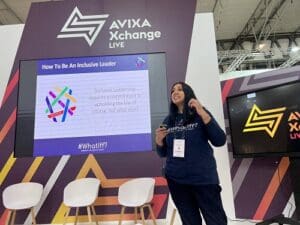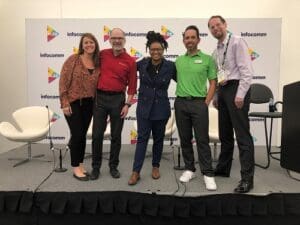At industry trade shows and events, we thrive when we connect with one another and learn more about different business practices, organizational structures, supply-chain risk-mitigation strategies and more. One such platform that allows AV professionals to share and learn is the discussion panel. However, most of these panels seem to have a common problem: a dearth of representation, especially on panels that are technical.
While the commercial AV industry has made progress regarding equity and representation, it is imperative that we reflect that change on trade-show panels, during discussions and in other platforms for engagement. A pair of respected industry figures — Alesia Hendley from Sennheiser and Iffat Chaudhry from Involve Visual Collaboration — speak with Commercial Integrator about how event organizers can ensure that all voices are given fair representation, while avoiding the pitfall of tokenism.
Hendley and Chaudhry emphasize the importance of having truly diverse panels and how doing so can benefit not only those attending the discussion but also the AV industry as a whole.
Why Inclusion Matters
We all know a foundational truth: Inclusion is not about exclusion; instead, it’s about creating a place for all people. Chaudhry, bid manager at Involve, observes that, in order to achieve inclusion, you have to consider equity for everyone. “Having an approach or policy for inclusion should not disadvantage anyone else,” she elaborates. Thus, according to Chaudhry, it is important to recognize the huge difference between (a) treating everyone the same way and (b) actively creating a level playing field for all by addressing individual needs. She adds, “It requires the time and desire to acknowledge what may be disadvantaging one person, or even a group of people.”
This, Chaudhry believes, can be achieved through positive communication in which decision-makers reach in, rather than waiting for employees or peers to reach out. “When that is in place,” she says, “it naturally allows for a safer environment for everyone to feel valued, and to participate and speak up without fear of recrimination.”
Hendley, business development manager for the southeast region at Sennheiser, agrees. She looks back to the George Floyd murder and #BlackLivesMatter movement, saying people really sat up and took notice of the racial injustice in society, as well as within the AV industry. “At that time, some trade shows really dove deep into looking for diversity [and representation],” Hendley explains. She opines that, today, we need to keep expanding the horizon of our thinking. “We are [still] in our little AV box all the time,” Hendley observes. “[But] we need to look externally and internally at the same time to bring about that balance.”
According to Hendley, our collective vision shouldn’t be so much about “DEI initiatives”; rather, it should be about conveying a collective message: “We need to bring more people [from all backgrounds] into all spaces — not just because they’re diverse but also because of the knowledge they have to offer.” Indeed, inclusion is about expanding the number of seats at the table, thus bolstering and diversifying the perspectives, experiences and knowledge being shared.
‘Inclusivity, in its truest form, should allow for all to feel welcome and for all to be able to access whatever is on offer.’ Iffat Chaudry, Involve.
The Danger of Tokenism
The flip side of efforts to build an inclusive environment is that they can lead to tokenism. Hendley argues that tokenism can actually hinder organizations and people’s efforts, saying, “Tokenism has hurt us more than it has benefited us.” In fact, in her opinion, “DEI” has transformed more into a buzzword rather than a course of action to genuinely move under-represented groups forward. “I think tokenism comes in because [we] always come as an afterthought,” Hendley adds. She cites the example of event organizers building out a panel, and then realizing right before the event that there are no people of color. “This is where the last-minute panic comes in,” she reflects. “And then, there’s a scramble to find all the people of color they know just to fill those spots.”
According to Hendley, this puts those very people in a tough position. “Of course, we want to put our names out there,” she asserts. “But if we’re informed only a week [or days] prior — or [if we’re] asked to lead a diversity discussion or reach out to our connections to add more diversity — that is definitely not the right way.”
Chaudhry, too, expresses her frustration with the tokenism prevalent in our industry. “I am not blind to the fact that I have been invited to things [to check off] the box of ‘POC’ and ‘female,’” she says. “And now, with my advancing years, I will add ‘age’ to that!” Like Hendley, Chaudhry does not agree with taking action merely for the sake of it. She has also often questioned the validity of “doing something rather than nothing.” As Chaudhry explains, “The danger with [that is], if your organization is not fully onboard with the DEI initiatives being introduced, you are at high risk of creating a very toxic [environment].”
Furthermore, Chaudhry points out that, if people don’t understand what the equity initiatives entail, or if they disappointedly say, “We’re not allowed to do this anymore,” then those from under-represented groups can actually find themselves facing even greater issues. Thus, she advises, “Don’t bother, unless you actually really want it and are committed to changing your environment properly — not because you have to but [rather] because you want to be better.”
Indeed, having the intention to include all voices is important, but it’s even more pertinent to approach it in the right way. But how can event organizers, and even companies, achieve this? In the next section, Hendley and Chaudhry dive into how we can truly make a difference.
Ensuring Fair Representation in Panels

Iffat Chaudhry, host of #WhatIff?, a podcast that addresses topics involving diversity, equity and inclusion in AV, speaks at a panel discussion as part of AVIXA’s Xchange Live.
Chaudhry points out that, when shows and events are scheduled far in advance, there is plenty of time for organizers to find a diverse range of voices. “Perhaps encourage previous participants to nominate other, lesser-known people from the industry to speak, as well,” she suggests. Observing that many industry panels still consist exclusively of white males, Chaudhry adds, “There are plenty of people from differing backgrounds, genders [and] races who would step up to speak, [if] given the opportunity.” All it takes is for is to give that opportunity to them.
Chaudhry notes that many industry professionals are now standing in solidarity with their colleagues in this cause. “I have spoken to many and seen in various conversations online — including in #AVintheAM threads — that many #avtweeps state that they will not join a panel unless there is fair representation therein,” she explains. However, Chaudhry cautions organizers not to place these people in a situation where they have to decline the opportunity to speak. “The chances are, these are exactly the kind of people you do want to have on panels,” she reasons.
Hendley underscores that a strategic approach is the best way to ensure fair representation. “It starts with the organization or trade show itself,” she begins. “[They have] to have that diverse mindset.” She believes that this means event organizers should evaluate everyone whom they showcase within the organization. Hendley adds, “It’s not even just from a panel perspective; it also means looking at who is on the show floor and in the booths.” She believes that, when the organization itself has a diverse group of people, that team is then better equipped to partner with vendors and exhibitors to make equity more of a true initiative.
But, even more than that, organizations need to look at the unconscious biases that exist within and outside themselves and their events. “I don’t think everybody’s a racist, and I don’t think people do it intentionally,” Hendley states. “However, there is [definitely] unconscious bias, and you have to be able to address that.” She adds, “That means putting in a more conscious effort and really being the change you want to see.”
Other Inclusive Strategies
As we observed earlier, inclusion can go a long way toward making everyone feel that they belong within our community. Hendley and Chaudhry emphasize that there are several other initiatives that trade-show organizers and participating companies can engage in to provide that inclusive environment during events.

Alesia Hendley (center) poses with TD SYNNEX’s Sandi Stambaugh; Iowa State University’s Mike Pedersen, CTS-D, CTS-I; CTI’s Tobi Tungl, CTS-D, RCDD; and CI editor-in-chief Dan Ferrisi for a panel discussion at InfoComm 2022.
Drawing on her own experiences, Hendley mentions that, on the vendor side, many people from marginalized backgrounds do not get to attend trade shows, as they tend to mostly do onsite work. “Instead of having the technical person of color attend and be on the panel, [companies] choose to leave them in the field,” she reveals. Hendley stresses that businesses need to look beyond just having salespeople in attendance. “Yes, we need the salespeople, because we want to sell,” she remarks. “But we also need those technical people — who are living and breathing these technologies day in and day out — to speak on these panels from a technical perspective.”
Thus, Hendley advises companies to reevaluate the teams that attend trade shows and industry events. “Most people in this industry who are people of color are in engineering or another tech field,” she underscores. “Yet, they don’t get to experience these shows.” Hendley adds, “By changing things up, these people will have the opportunity to not only experience but also speak and [add] value to the show.”
Meanwhile, Chaudhry advocates for building accessibility awareness at trade shows and events in order to cater to every single attendee. She brings up how British Sign Language (BSL) became a recognized language in the U.K. in 2022. “This is a major step forward for the Deaf community,” she notes. “And I am delighted to work for a company that embraces this and supports many other organizations in supporting access to BSL interpreters for all events.” Chaudhry also highlights the lack of wheelchair access at a major trade event. “The corridors [were] wide enough, but too many stands required a step up and did not have a ramp facility,” she recalls. This, Chaudhry says, made it hard for anyone in a wheelchair to access the stands.
Chaudhry believes that event organizers need to keep such accessibility accommodations in mind for future events. As she astutely notes, “Inclusivity, in its truest form, should allow for all to feel welcome and for all to be able to access whatever is on offer.”
The road to achieving diversity, equity and inclusion is certainly not easy. However, we can bring about the change we all long to see if we commit to ensuring each initiative that we undertake — no matter how small — is meaningful, sincere and comes from within.

![the Building blocks of representation [title slide]](https://www.commercialintegrator.com/wp-content/uploads/2023/04/Building-blocks-of-representation.jpg)








